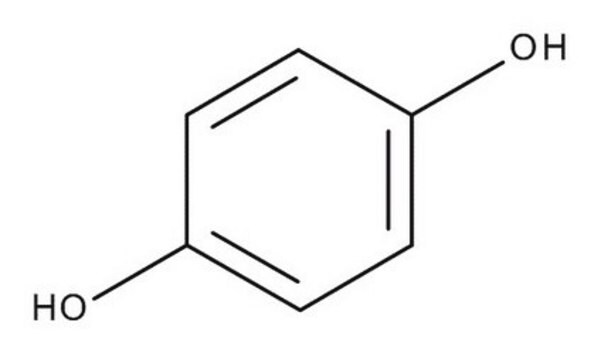1324002
USP
Hydroquinone
United States Pharmacopeia (USP) Reference Standard
Sinónimos:
1,4-Benzenediol, 1,4-Dihydroxybenzene, HQ
About This Item
Productos recomendados
grade
pharmaceutical primary standard
vapor density
3.81 (vs air)
vapor pressure
1 mmHg ( 132 °C)
API family
hydroquinone
autoignition temp.
930 °F
manufacturer/tradename
USP
bp
285 °C (lit.)
mp
172-175 °C (lit.)
application(s)
pharmaceutical (small molecule)
format
neat
SMILES string
Oc1ccc(O)cc1
InChI
1S/C6H6O2/c7-5-1-2-6(8)4-3-5/h1-4,7-8H
InChI key
QIGBRXMKCJKVMJ-UHFFFAOYSA-N
¿Está buscando productos similares? Visita Guía de comparación de productos
General description
Application
Also, for use with USP monographs such as:
- Hydroquinone Cream
- Hydroquinone Topical Solution
Analysis Note
Other Notes
Related product
signalword
Danger
Hazard Classifications
Acute Tox. 4 Oral - Aquatic Acute 1 - Aquatic Chronic 1 - Carc. 2 - Eye Dam. 1 - Muta. 2 - Skin Sens. 1B
Storage Class
11 - Combustible Solids
wgk_germany
WGK 3
flash_point_f
329.0 °F - closed cup
flash_point_c
165 °C - closed cup
Elija entre una de las versiones más recientes:
Certificados de análisis (COA)
It looks like we've run into a problem, but you can still download Certificates of Analysis from our Documentos section.
Si necesita más asistencia, póngase en contacto con Atención al cliente
¿Ya tiene este producto?
Encuentre la documentación para los productos que ha comprado recientemente en la Biblioteca de documentos.
Nuestro equipo de científicos tiene experiencia en todas las áreas de investigación: Ciencias de la vida, Ciencia de los materiales, Síntesis química, Cromatografía, Analítica y muchas otras.
Póngase en contacto con el Servicio técnico








